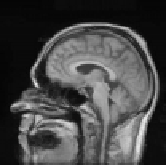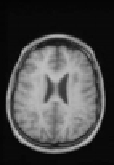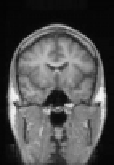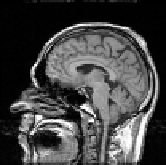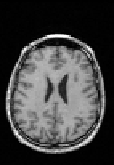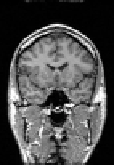Biomedical Engineering Reference
In-Depth Information
Robust multigrid registration
Reference subject
Figure 8.19:
Results of experiments on a database of 18 subjects. One subject
was chosen as the reference subject (bottom), and we averaged all the recon-
structed volumes after robust multigrid registration (top). We kept the same set
of parameters for all the subjects, which demonstrates the robustness of the
method. Results of the averaging after registration show the accuracy of the
registration (after averaging we can distinguish precisely anatomical structures
such as ventricles, deep nuclei, white matter tracks and even cortical regions).
For gray matter tissue, the average overlap after registration is 93
.
9% (mean of
total performance). For white matter, the average overlap is 94
.
9%. If we perform
a rigid registration by maximization of mutual information, we obtain 88
.
3% and
87
.
1% of average overlap, for gray matter and white matter, respectively. These
measures must be interpreted carefully for two reasons. We use binary classes
(and not fuzzy classes) and a simple trilinear interpolation scheme, which may
introduce some error. Furthermore, the classification algorithm introduces er-
rors that disturb the overlapping measure. In the last 5% to recover, it is difficult
to distinguish what is due to the registration process and what is due to inter-
polation and segmentation errors. However, these overlapping measures show
the benefit of non-rigid registration.
8.3.3.5
Experiments on Multimodal Datasets
The extension of Romeo to multimodal dataset was motivated by a particu-
lar problem: the correction of distortions in echo-planar images. Among the
